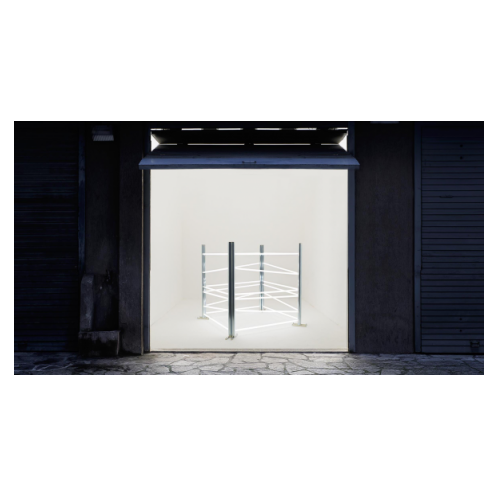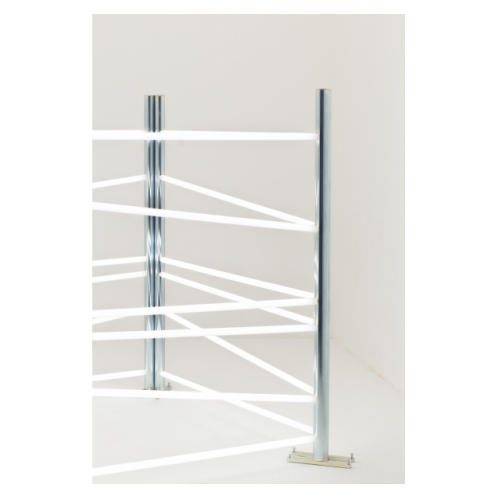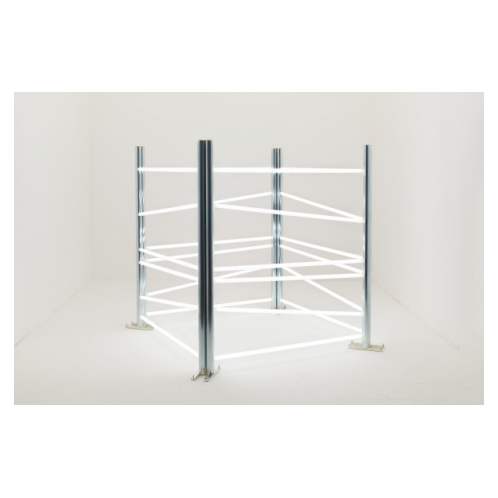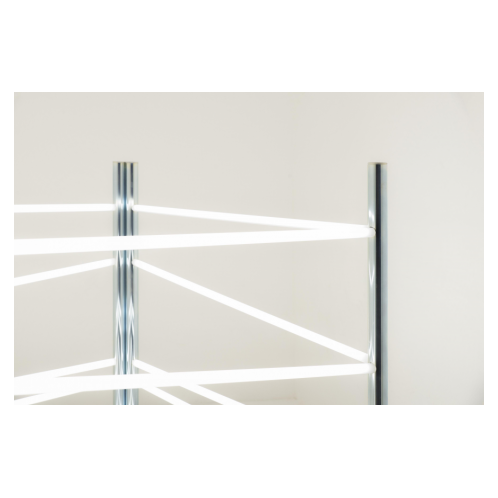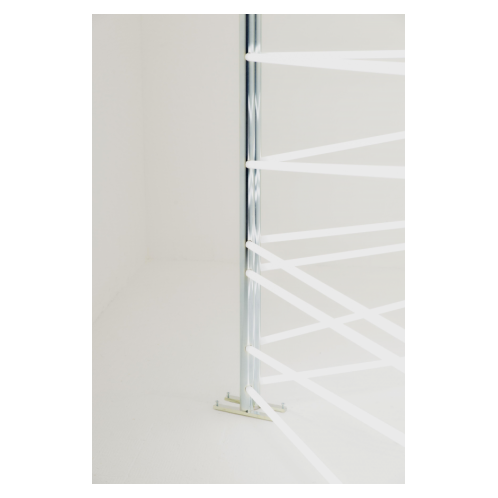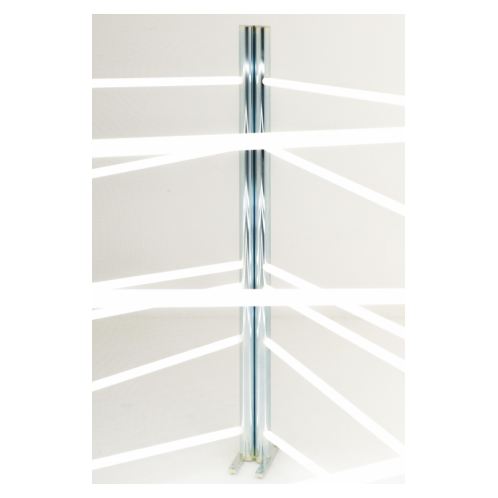Sergio Limonta
Download Press Release in PDF Format ![]()
SERGIO LIMONTA
LAST MIRAGES
a cura di
GIORGIO VERZOTTI
INAUGURAZIONE
MERCOLEDI 5 FEBBRAIO 2020
ORE 18-21
dal 5 febbraio al 30 marzo 2020 solo su appuntamento
L’opera che Sergio Limonta ha creato appositamente per The Open Box si intitola Last mirages perché fin dal titolo vuole enfatizzare un proprio valore evocativo.
Luce su luce, nel bianco dello spazio espositivo l’artista inserisce una struttura che quell’ambiente quasi occupa totalmente e interamente illumina. La struttura delinea nello spazio un cubo, più precisamente è costituita da quattro coppie di pali in metallo zincato che reggono ventiquattro luci tubolari, sei per ogni lato.
L’evocazione forse inizia da qui perché la figura del solido geometrico è appunto indicata più che realizzata, ne vediamo lo scheletro, che per altro non ha l’assiomatica prevedibilità delle griglie metalliche bianche di Sol Lewitt. Qui i tubi luminosi non sono ordinati ortogonalmente, ma si presentano variamente inclinati, in uno schema che si ripete sulle quattro facce del cubo, però ribaltato rispetto a quello adiacente, producendo incroci visivi apparentemente caotici quasi disturbanti, in una figura che sembra sul punto di disfarsi.
Le luci tubolari non “reggono”, sono solo appoggiate all’interno degli appositi fori nei pali metallici che le accolgono, non sono connessioni solide; la struttura congiunge all’idea di disordine anche quella di fragilità e provvisorietà. La luce veicola naturalmente questa impressione generale di smaterializzazione, accentuata dalla collocazione dell’opera dentro il white cube dello spazio espositivo.
L’idea formale riprende un tema procedurale tipico di Limonta, il definire volume e ingombro propri della scultura a partire da un motivo bidimensionale, poi semplicemente reiterato secondo le facce di un ipotetico solido cubiforme.
La definizione del “motivo” questa volta si affida al lontano ricordo, un miraggio della memoria appunto, di un racconto fatto all’artista ancora studente dal compianto gallerista milanese Luciano Inga Pin; quello di un Dan Flavin che non smette mai di disegnare neanche nel letto dell’ospedale dove morirà e le prove estreme sono semplici disegni di luci al neon non organizzate secondo le note combinazioni dell’artista, ma singolarmente sospese nello spazio del foglio quasi galleggiassero nel vuoto. Con esili e morbide linee di cavi elettrici posti agli estremi di ognuna che proseguono fino agli estremi del foglio verso un oltre insondato.
In quei disegni non c’è colore e il segno essenziale del solo profilo forse sta per l’indicazione di una luce pura, bianca, simile a quella che ora circonfonde l’immagine geometrica delineata da Limonta, che intende con questo concretizzare quella suggestione con una scultura nitida nella forma quanto leggera fino a sembrare fatta di puri raggi luminosi.
Last mirages però ci consegna anche un’altra serie di riflessioni generali che la luce qui emblematizza, smaterializzando l’oggetto: l’opera si presenta nella mente dell’artista come un miraggio, qualcosa che non esiste fino a che l’artista non deciderà di concretizzarla. Essa per altro ridiventerà un miraggio, quando sia costituita da materiali effimeri e comunque destinati, come molta arte moderna e contemporanea, a non permanere a lungo. E perciò molta arte dal Novecento in poi si ammira tutt’ora perché è stata rifatta con materiali nuovi a sostituzione degli originali, di essa rimane l’idea ogni volta reincarnata, lasciandoci forse la nostalgia dell’originale, dell’unicum, che possiamo vivere ormai solo come miraggio…
Luce su luce, nel bianco dello spazio espositivo l’artista inserisce una struttura che quell’ambiente quasi occupa totalmente e interamente illumina. La struttura delinea nello spazio un cubo, più precisamente è costituita da quattro coppie di pali in metallo zincato che reggono ventiquattro luci tubolari, sei per ogni lato.
L’evocazione forse inizia da qui perché la figura del solido geometrico è appunto indicata più che realizzata, ne vediamo lo scheletro, che per altro non ha l’assiomatica prevedibilità delle griglie metalliche bianche di Sol Lewitt. Qui i tubi luminosi non sono ordinati ortogonalmente, ma si presentano variamente inclinati, in uno schema che si ripete sulle quattro facce del cubo, però ribaltato rispetto a quello adiacente, producendo incroci visivi apparentemente caotici quasi disturbanti, in una figura che sembra sul punto di disfarsi.
Le luci tubolari non “reggono”, sono solo appoggiate all’interno degli appositi fori nei pali metallici che le accolgono, non sono connessioni solide; la struttura congiunge all’idea di disordine anche quella di fragilità e provvisorietà. La luce veicola naturalmente questa impressione generale di smaterializzazione, accentuata dalla collocazione dell’opera dentro il white cube dello spazio espositivo.
L’idea formale riprende un tema procedurale tipico di Limonta, il definire volume e ingombro propri della scultura a partire da un motivo bidimensionale, poi semplicemente reiterato secondo le facce di un ipotetico solido cubiforme.
La definizione del “motivo” questa volta si affida al lontano ricordo, un miraggio della memoria appunto, di un racconto fatto all’artista ancora studente dal compianto gallerista milanese Luciano Inga Pin; quello di un Dan Flavin che non smette mai di disegnare neanche nel letto dell’ospedale dove morirà e le prove estreme sono semplici disegni di luci al neon non organizzate secondo le note combinazioni dell’artista, ma singolarmente sospese nello spazio del foglio quasi galleggiassero nel vuoto. Con esili e morbide linee di cavi elettrici posti agli estremi di ognuna che proseguono fino agli estremi del foglio verso un oltre insondato.
In quei disegni non c’è colore e il segno essenziale del solo profilo forse sta per l’indicazione di una luce pura, bianca, simile a quella che ora circonfonde l’immagine geometrica delineata da Limonta, che intende con questo concretizzare quella suggestione con una scultura nitida nella forma quanto leggera fino a sembrare fatta di puri raggi luminosi.
Last mirages però ci consegna anche un’altra serie di riflessioni generali che la luce qui emblematizza, smaterializzando l’oggetto: l’opera si presenta nella mente dell’artista come un miraggio, qualcosa che non esiste fino a che l’artista non deciderà di concretizzarla. Essa per altro ridiventerà un miraggio, quando sia costituita da materiali effimeri e comunque destinati, come molta arte moderna e contemporanea, a non permanere a lungo. E perciò molta arte dal Novecento in poi si ammira tutt’ora perché è stata rifatta con materiali nuovi a sostituzione degli originali, di essa rimane l’idea ogni volta reincarnata, lasciandoci forse la nostalgia dell’originale, dell’unicum, che possiamo vivere ormai solo come miraggio…
LAST MIRAGES, 2019-2020, metallo zincato, lampade tubolari, impianto elettrico, viti, cm 130 × 130 × 140 ca.
THE OPEN BOX
Via G.B. Pergolesi 6
20124
MILANO
www.theopenbox.org
+393382632596![]()
SERGIO LIMONTA
LAST MIRAGES
curated by
GIORGIO VERZOTTI
OPENING
WEDNESDAY 5 FEBRUARY 2020
6-9 PM
from 5 February to 30 March 2020 by appointment only
Last mirages, the work that Sergio Limonta has created specifically for The Open Box, is intended from its very title to emphasise an evocative value.
Light on light, the artist has inserted a structure within the white of the exhibition space that almost wholly occupies and entirely illuminates the environment. The structure delineates a cube in space; to be precise it is composed of four pairs of galvanized metal posts that support 24 tubular lights, six on each side.
The evocation perhaps begins here, with the shape of the geometric solid being indicated rather than actually created and what we see is a skeleton that lacks even the axiomatic predictability of the white metal grids of Sol LeWitt. Here the luminous tubes are not regularly ordered and parallel to one another but are variously inclined, in a configuration that is repeated on all four faces of the cube but overturned with respect to the neighbouring ones. This produces apparently chaotic and almost disorienting visual intersections in a shape that appears to be on the point of coming apart.
The tubular lights are not “load bearing”, they are merely slotted into the holes drilled into the metal posts holding them, they are not solid connections; the structure combines the idea of disorder with that of fragility and impermanence. The light naturally conveys this overall impression of dematerialization, accentuated by the placing of the work within the white cube of the exhibition space.
The formal idea reprises a procedural theme typical of Limonta, the definition of the volume and encumbrance of a sculpture on the basis of a two-dimensional motif, which is simply reiterated on the faces of a hypothetical cubiform solid.
On this occasion, the definition of the “motif” is entrusted to a distant memory, a mirage in fact of the memory of a story told to the artist when still a student by the late Milanese gallerist Luciano Inga Pin; that of a Dan Flavin who never stopped drawing even on his hospital deathbed, simple designs of neon light organized not according to the artist’s noted combinations, but individually suspended in the space of the sheet of paper, almost as if they were floating in the void. With the thin, soft lines of electrical cables at the ends of each light heading to the edges of the paper and an unknown beyond.
In those drawings there is no colour and the simple mark of a single profile perhaps indicates a pure white light, similar to that which now bathes the geometric image delineated by Limonta, whose intention is to concretize that suggestion with a sculpture as focused in form as it is insubstantial to the point of seemingly being composed of pure luminous rays.
However, Last mirages also conveys another series of general reflections that the light symbolizes here, dematerializing the object: the work presents itself in the mind of artist as a mirage, something that does not exist until the artist decides to concretize it. It will, moreover, become a mirage again as it is composed of ephemeral materials and is in any case destined, like much modern and contemporary art, not to last long. Much art from the 20th century onwards can in fact only be admired today because it has been remade with new materials replacing the originals, with what survives being the idea every time it is reincarnated, leaving us perhaps nostalgic for the original, the unicum, which we can now only experience as a mirage...
LAST MIRAGES, 2019-2020, galvanized metal, tube lights, electrical system, screws, cm 130 × 130 × 140 approx.
The tubular lights are not “load bearing”, they are merely slotted into the holes drilled into the metal posts holding them, they are not solid connections; the structure combines the idea of disorder with that of fragility and impermanence. The light naturally conveys this overall impression of dematerialization, accentuated by the placing of the work within the white cube of the exhibition space.
The formal idea reprises a procedural theme typical of Limonta, the definition of the volume and encumbrance of a sculpture on the basis of a two-dimensional motif, which is simply reiterated on the faces of a hypothetical cubiform solid.
On this occasion, the definition of the “motif” is entrusted to a distant memory, a mirage in fact of the memory of a story told to the artist when still a student by the late Milanese gallerist Luciano Inga Pin; that of a Dan Flavin who never stopped drawing even on his hospital deathbed, simple designs of neon light organized not according to the artist’s noted combinations, but individually suspended in the space of the sheet of paper, almost as if they were floating in the void. With the thin, soft lines of electrical cables at the ends of each light heading to the edges of the paper and an unknown beyond.
In those drawings there is no colour and the simple mark of a single profile perhaps indicates a pure white light, similar to that which now bathes the geometric image delineated by Limonta, whose intention is to concretize that suggestion with a sculpture as focused in form as it is insubstantial to the point of seemingly being composed of pure luminous rays.
However, Last mirages also conveys another series of general reflections that the light symbolizes here, dematerializing the object: the work presents itself in the mind of artist as a mirage, something that does not exist until the artist decides to concretize it. It will, moreover, become a mirage again as it is composed of ephemeral materials and is in any case destined, like much modern and contemporary art, not to last long. Much art from the 20th century onwards can in fact only be admired today because it has been remade with new materials replacing the originals, with what survives being the idea every time it is reincarnated, leaving us perhaps nostalgic for the original, the unicum, which we can now only experience as a mirage...
LAST MIRAGES, 2019-2020, galvanized metal, tube lights, electrical system, screws, cm 130 × 130 × 140 approx.
THE OPEN BOX
Via G.B. Pergolesi 6
20124
MILANO
www.theopenbox.org
info.theopenbox.org@gmail
+393382632596

